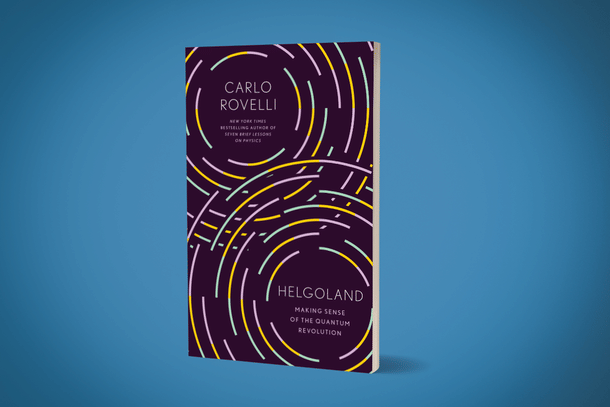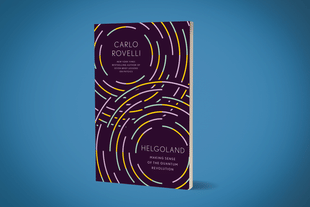Science
'Helgoland' Review: A Grounding In Indian Philosophy Can Help In Understanding Quantum Mechanics Better; Where Is India's Carlo Rovelli?
Aravindan Neelakandan
Sep 19, 2021, 04:33 PM | Updated 04:33 PM IST
Save & read from anywhere!
Bookmark stories for easy access on any device or the Swarajya app.


Helgoland: Making Sense of the Quantum Revolution. Carlo Rovelli. Penguin. Pages 175. Rs 759 (Kindle).
‘New Physics’, whose emergence dates back to almost a century, is one of the finest achievements of the human mind. It has fundamentally changed the way we view reality. There have been umpteen number of books which tell non-physicists what ‘New’ Physics is all about. From that masterpiece, The Universe and Dr. Einstein by Lincoln Barnett in 1948 to The God Equation of Michio Kaku in 2021, the need to communicate the exotic reality which the theory of relativity and quantum mechanics have unveiled, has spawned the best in the genre of popular science writing.
In the same way, Quantum Mechanics (QM) has also triggered some intense philosophical debates. From the very beginning, parallels have been drawn between the worldview revealed by QM and the one spoken about in the Hindu-Buddhist-Taoist mystical traditions. Niels Bohr, Heisenberg, and John Wheeler had openly spoken about their engagement with Eastern mystic philosophies.
Fritjof Capra not only made this connection popular but also extended the concepts of interconnectedness and holism, which are favoured by QM, into other domains such as biology and ecology. The conversations between physicist David Bohm and J. Krishnamurthi are still considered an important milestone in this direction.
However, QM in the popular culture has also become a staple diet of New Age cultists and quake-gurus. The abuse of the Q-word in the new age market and corporate gurudom has actually made many scholars stay muted in exploring and using the parallels between Eastern philosophical traditions and the view of reality brought forth by QM.
In this context, Helgoland: Making Sense of the Quantum Revolution, written by theoretical physicist Carlo Rovelli, comes across as a gush of fresh air.
Helgoland is the small island where in 1925, the 23-year-old Heisenberg worked out what would be one of foundations of the quantum revolution. Right from the beginning, Rovelli makes a sense of awe grip the reader:
There was a moment when the grammar of the world seemed clear: at the root of the variegated forms of reality, just particles of matter guided by a few forces. Humankind could think that it had raised the Veil of Maya, seen the basis of the real. It didn’t last. Many facts did not fit. Until, in the summer of 1925, a twenty-three-year-old German spent days of anxious solitude on a windswept island in the North Sea: Helgoland—in English also Heligoland —the Sacred Island.
The author informs that the book is written 'for those who are unfamiliar with quantum physics and are interested in trying to understand, as far as any of us can,’ and is also written ‘thinking of my colleagues—scientists and philosophers, who, the more they delve into the theory, the more they are perplexed…’. That is a tough endeavour – but for those who read the book the flow is so natural and gripping that one forgets the difficulty of the feat this book accomplishes.
QM has always excited physicists and philosophers. However, physicists have always disliked it when philosophers try to come up with a single, complete picture of QM– as in the case of David Bohm’s ‘hidden variables.’
Just see how crisply Rovelli puts it for the readers:
The Hidden Variables interpretation brings quantum physics back into the same logical realm as classical physics: everything is deterministic and predictable. If we knew the position of the electron and the value of the wave, we could predict everything. But it’s not really as simple as this. As it happens, we cannot ever know the wave, because we never see it: we only see the electron. Hence the behavior of the electron is determined by variables (the wave) that for us remain hidden. The variables are hidden in principle: we can never determine them. This is how the theory gets the name Hidden Variables. The price to be paid for taking this theory seriously is to accept the idea that an entire physical reality exists that is in principle inaccessible to us. … Bohm’s interpretation is favored by some philosophers because it offers a conceptually clear framework. But it is liked less by physicists, because as soon as you try to apply it to something more complicated than a single particle, problems accumulate.
This passage is quoted at large to show how Rovelli explains tough concepts to his readers. It is done in a way that everyone interested in QM can understand without the subject-matter being diluted.
Rovelli's own favoured view of QM is what is called the relational interpretation. According to this, the interactions and relations between matter form what we experience as reality, from quarks to galaxies. This resonates with the fabled Indra’s Net in a way – popularised in the context of modern science, though in a different-yet-related domain, by Douglas Hofstadter in his ever-green classic Godel, Escher, Bach: An Eternal Golden Braid (1979).
Rovelli points out that when he talks about quanta in conferences, people invariably ask him about the 3rd century Buddhist philosopher, Nagarjuna. This how Rovelli describes Nagarjuna's ideas:
The central thesis of Nagarjuna’s book is simply that there is nothing that exists in itself independently from something else. The resonance with quantum mechanics is immediate. Obviously, Nagarjuna knew nothing, and could not have imagined anything, about quanta—that is not the point. ... The perspective offered by Nagarjuna may perhaps make it a little easier to think about the quantum world.
After this, the entire chapter becomes a poetic musing, interwoven with the relational interpretation of QM. Perhaps UGC should think of including excerpts from this chapter in the curricula our college students -whether science, commerce, art, or humanities.
Rovelli extends his approach to the topic of Consciousness as well and tries to tackle the 'Hard Problem' of David Chalmers. Here, Rovelli presents a view that is quite fascinating. Is consciousness or the 'I' an epiphenomenon of matter? He thinks both the 'I' and 'matter' are 'confused and misleading' concepts.
We have an intuition of unity when we think about ourselves, but this is justified by the integration of our body and by the ways our mental processes work, of which the part we call 'conscious' does one thing at a time.
The first term of the problem, the 'I,' is the residue of a metaphysical error: the result of the common mistake of mistaking a process for an entity. ... Even worse is the second term of the question, “matter.” It is, as well, the residue of an incorrect metaphysics based on too naive a conception of matter as a universal substance defined only by mass and motion. This is erroneous metaphysics because it is contradicted by quantum physics.
The Anatmavada of Buddhism could not have been put in more precise terms for the modern mind. But there are problems. Often, the Hindu-Buddhist dialogue of Atmavadin-anatmavadin is reframed in the Western mind as corresponding to Cartesian substance. Naturally, in that context, the Western mind veers towards the Buddhist stand.
That said, the book leaves one with a profound sense of having undertaken a pilgrimage.
This is a must-read book for the current generation of college-going students, whatever may be their chosen field of study. This also makes one realise an important lacunae in popular science writing in India. It is struck with either glorification of the past or with patronizingly cultivating ‘scientific temperament.’ Both alienate the general population from modern science. This gives way to quackery, pseudo-science and politicisation of science.
Think about this. After Helgoland there was Santiniketan. Fritjof Capra records:
In 1929 Heisenberg spent some time in India as the guest of the celebrated Indian poet Rabindranath Tagore, with whom he had long conversations about science and Indian philosophy. This introduction to Indian thought brought Heisenberg great comfort, he told me. He began to see that the recognition of relativity, interconnectedness, and impermanence as fundamental aspects of physical reality, which had been so difficult for himself and his fellow physicists, was the very basis of the Indian spiritual traditions. "After these conversations with Tagore," he said, "some of the ideas that had seemed so crazy suddenly made much more sense. That was a great help for me. "
That is definitely self-congratulatory. But we need to go beyond that comfort zone. This culture has fluidity in looking at existence. Looking at a kolam that comes up every morning. What is kolam but the interconnections between the points? What can be a better tool to communicate the wonder of all this existence arising out of relations and interconnections than a kolam? One wonders how much could have been written, bringing the wonders of QM to our society using our own cultural traditions. I'm not saying ‘we knew it all’ but that we can understand it better and internalise it more efficiently.
Atmanirbhar Bharat needs its own Rovellis.
Aravindan is a contributing editor at Swarajya.





